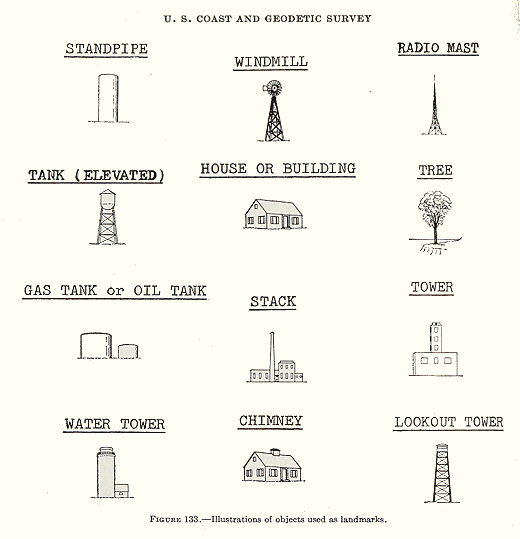
The following classifications, which include most landmarks, are defined and accompanied by remarks to standardize their use. These names shall be used so far as practicable.
- BUILDING
- (See House.)
- CHIMNEY
- That projecting part of a building for conveying smoke, etc., to the outer air. This term is to be used only where the building is the prominent feature and where charting of some specific part of it is desirable; for example, the chimney of a large factory.
- CUPOLA
- A small turret or dome-shaped tower rising from a building, in cases where the building is the prominent object and where the cupola is small as compared to the building.
- DOME
- A large cupola of rounded hemispherical form, or a roof of the same shape, whether it is actually rounded or many-sided.
- FLAGPOLE
- A single staff flagpole rising from the ground and not attached to a building.
- FLAGSTAFF
- A single staff flagpole rising from a building. This is not desirable is a landmark, due to its nonpermanence. Although it is desirable that the most definite part of a building (such as the flagstaff) be pointed at in making observations, this is not necessarily the most important part for charting purposes. Wherever possible give, for use on the chart, that part of the building from which the flagstaff rises, as TOWER, CUPOLA, DOME, etc.
- FLAG TOWER
- Any scaffold-like tower on which flags are hoisted, such as a Coast Guard skeleton steel flagpole or a Weather Bureau signal tower. Do not use Signal Tower.
- GAS TANK or OIL TANK
- Since these differ in shape and size from a water tank, the compound name will be used.
- HOUSE or BUILDING
- Although it is desirable to locate a house or building by observations on a specific point, as the west gable or the flagstaff, such terms are not desirable for charting purposes, where it is the structure itself which is the landmark. Use HOUSE or BUILDING followed by a description of the point in either capitals or lower-case letters, according to whether it should be used on the chart or not. Where the outline of the building should be shown on the chart, the following notation-“chart outline”-should be made on Form 567.
- LOOKOUT TOWER
- Any tower surmounted by a small house in which a watch is habitually kept, such as a Coast Guard lookout tower or a fire lookout tower. Do not use this term in describing an observation tower, or a part of a building in which no watch is kept.
- MONUMENT
- Do not use Obelisk or other terms.
- OIL TANK
- (See Gas Tank.)
- RADIO MAST
- A general term to include any tower, pole, or structure for elevating antennas.
- SPIRE
- In general, any slender pointed structure surmounting a building. The spire is rarely less than two-thirds of the entire height and its lines are rarely broken by stages or other features. Do not use Steeple. Spire is not applicable to a short pyramid-shaped structure rising from a tower or belfry.
- STACK
- Any tall smokestack or chimney, regardless of color, shape, or material, if the stack is more prominent, as a landmark, than any buildings in connection with it. Do not use Chimney.
- STANDPIPE
- A tall cylindrical structure, in a waterworks system, whose height is several times greater than its diameter.
- TANK
- A tank for holding water, when its base rests on the ground or other foundation, and its height is not much greater than its diameter.
- TANK (ELEVATED)
- A tank for holding water, where such tank is elevated high above the ground or other foundation by a tall skeleton framework.
- TOWER
- (a) A part of a structure higher than the rest, but having vertical sides for the greater part of its height.
- (b) An isolated structure with vertical sides (not otherwise classified), high in proportion to the size of its base, and of simple form.
- (c) The top of a skyscraper, high in proportion to its horizontal size and rising above its surroundings.
- (d) Any structure, whether its sides are vertical or not, with base on the ground and high in proportion to its base. Its sides may be open framework, such as a Bilby steel tower.
- TREE
- Do not use Lone tree or Conspicuous lone tree. This is assumed, otherwise the tree would not serve as a landmark.
- WATER TOWER (infrequent)
- A decorative structure enclosing a tank or standpipe, or used as such, when by its appearance it would not be recognized as such.
- WINDMILL
- A-self-explanatory term.